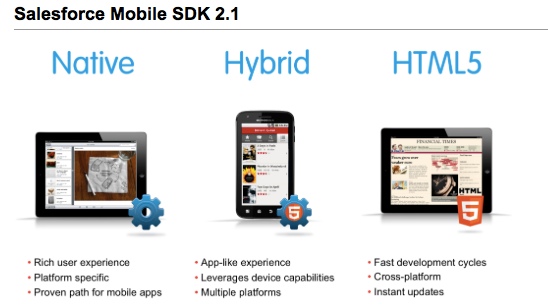As you can see from the Salesforce keynote, Mobile is extremely important to them and to customers.
Why Mobile Self-Service
Mobile devices are ubiquitous. Q4 was the inflection point where more phones and tablets exist than pc’s and laptops.
Study: Frost and Sullivan analysis show that users already use mobile devices for a wide ranges of activities.
Three examples of great mobile self-service apps:
- Geico
- Take picture of the accident
- take down license and insurance info
- Home Depot
- Natural language search
- store layout
- bar code search
- Fixya
Salesforce 1 lets you surface the data and interactions within the app. it’s not the only option though, you can build your own custom mobile apps or an ISV partner can build them. The mobile app exchange also has a large number of purpose built mobile apps. In other words, you have lots of options.
Salesforce wants to give you a range of options:
- Native applications
- Hybrid apps
- html5 web apps

Hybrid Application
These apps run on a native container but then add functionality. It leverages the browser engine to render the html while accessing the native phone capabilities.
Two options for Hybrid include:
- Hybrid Remote: easy access to visual force, Possible to avoid API calls. Doesn’t support offline very easily
- Hybrid Local: Most of the html lives on the device, it’s a pure javascript deployment, can take offline easily, and makes fewer seder side calls for assets
Using Javascript, you can access native apps like the camera and contacts.
Salesforce Mobile SDK 2.1
Available for Android and iOS. Support native, hybrid, and html5 apps. Geared towards all levels of developers.
SmartSync and SmartStore are Key
Smartsync: lets you sync up your app when you come back online
SmartStore: Securely stored encrypted data on your phone
Key URL’s
http://developer.force.com/join
http://developr.force.com/mobile
http://boards.deeloperforce.com
Demo
Patient Portal
- Starts with a dashboard
- Shows health scores, gamifiation rewards activity, reminders, and trends
- Built on communities and Force.com
- Has a goal of increasing interaction with patient and physician
- A lot of the data are individual data like exercise, sleep, and weight. (less Meaningful Use patient portal and more consumer oriented)
- Shows the care team / My Doctors
- includes appointment scheduling
- Integrates financial information and even looks at claims coverage
- Shows patient records like test results. (This is obviously a demo given the mockup of everything without thinking about the fact that all the doctor use different systems and hospitals)
- Gamification uses Total Rewards system based on your exercise levels, weight, etc.
- Integrates chatter for better interaction. (no mention of PHI at all)
Field Service Professional
- This is a field service application developed on Native iOS
- Includes Sync with SmartSync
- Work orders sync and show in a list and a map
- The app sorts by priority or time (for when you have SLA’s)
- Can do smart routing and/or integrate with Google Maps
- Drill down into the work order and see the data
- All of this pulls data from the backend
- It allows digital wet signatures and takes payment with PayPal (first payment gateway, others aren’t hard.)
- You can also give the customer a survey
- and finally commit the completed work order
I love the thought process and the thought put into creating something like this. I think the patient portal especially show a little bit of naivety in thinking you can bring all that together without a lot of back end work. That said, the use of SmartSync and SmartStore in the apps is a great showcase to say you can work within regulations and security needs.
PwC starts with native applications because of the better performance, etc. User experience, and data persistence also come into play. For example, if you want a completely branded app then maybe a custom native app makes sense.
What solutions exist that are more out of the box
The goal is to allow you to build and customize more declaratively.
PKB3: Public Knowledge Base 3 lets you stand up a knowledge base and configure from there. It’s delivered as a web app. It’s an app exchange package available for free.
Mobile Self-Service: Enhance PKB3 with a much nicer interface. includes authentication, and forums.
Mobile self service just went live on the app exchange. It’s free. You can deploy as web app. You can also build a wrapper around a hybrid application. In many ways, it’s just a bunch of templates or VisualForce pages to give you a start. It’s also fairly configurable with logo, colors, contact phone, turn on and off key functionality. Again, it’s a good start for similar apps you may want to build.
The Future
Will build self-service using Site.com. This will make it even easier to customize and will support responsive templates out of the box. The roadmap session today and Thursday will demo this.
